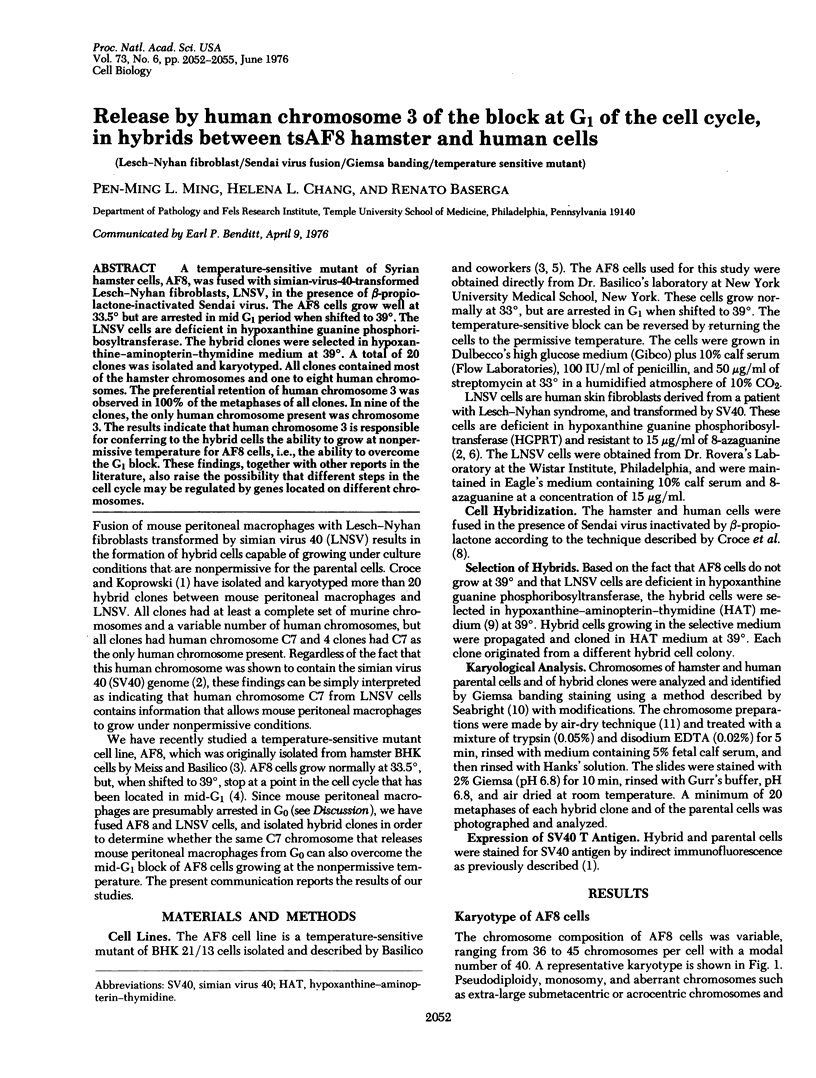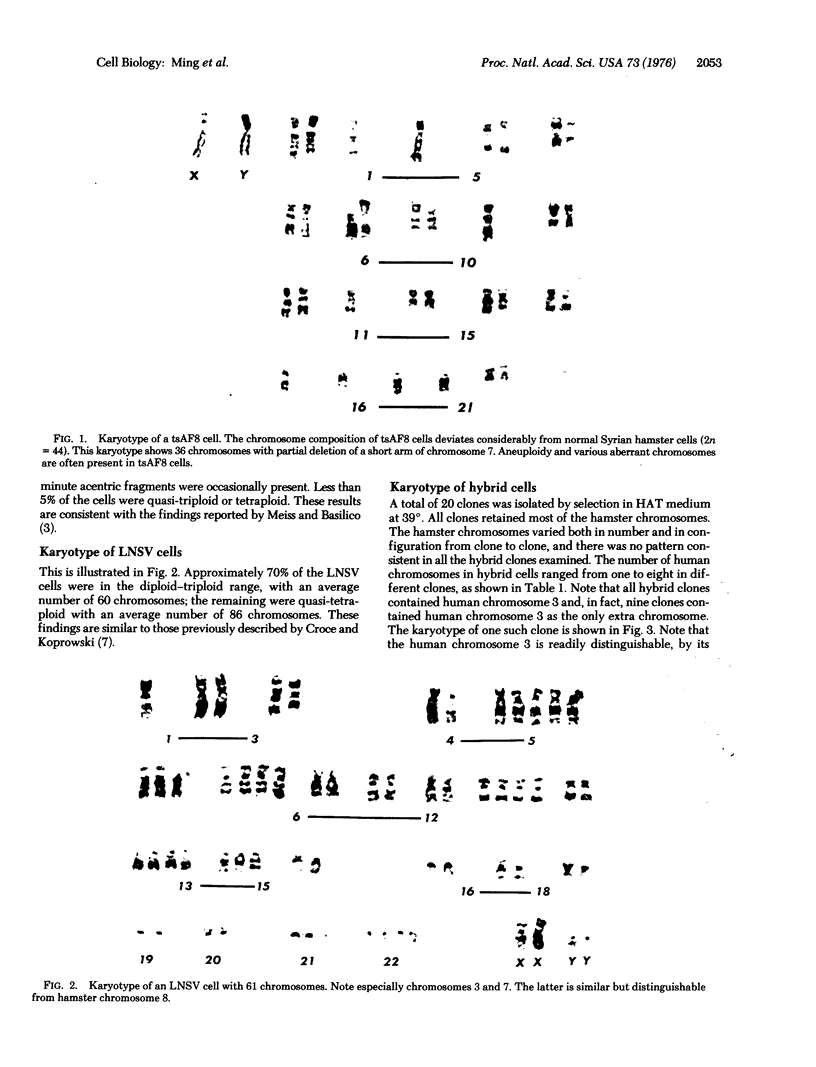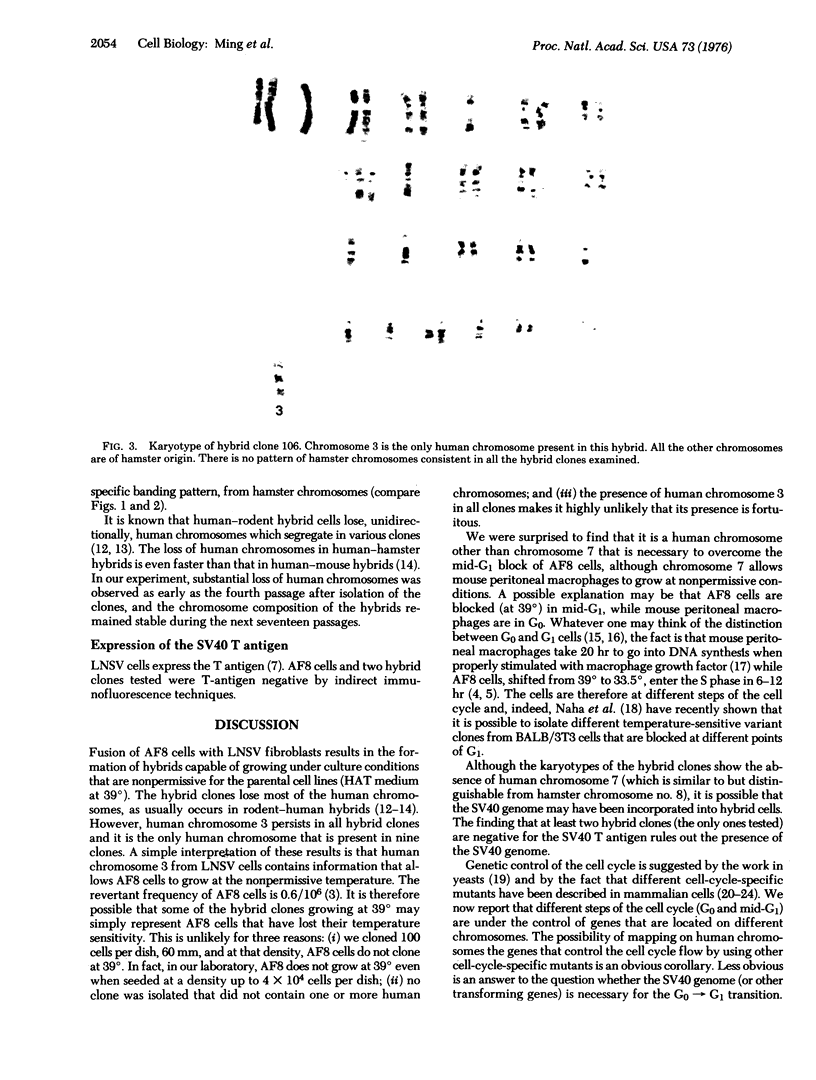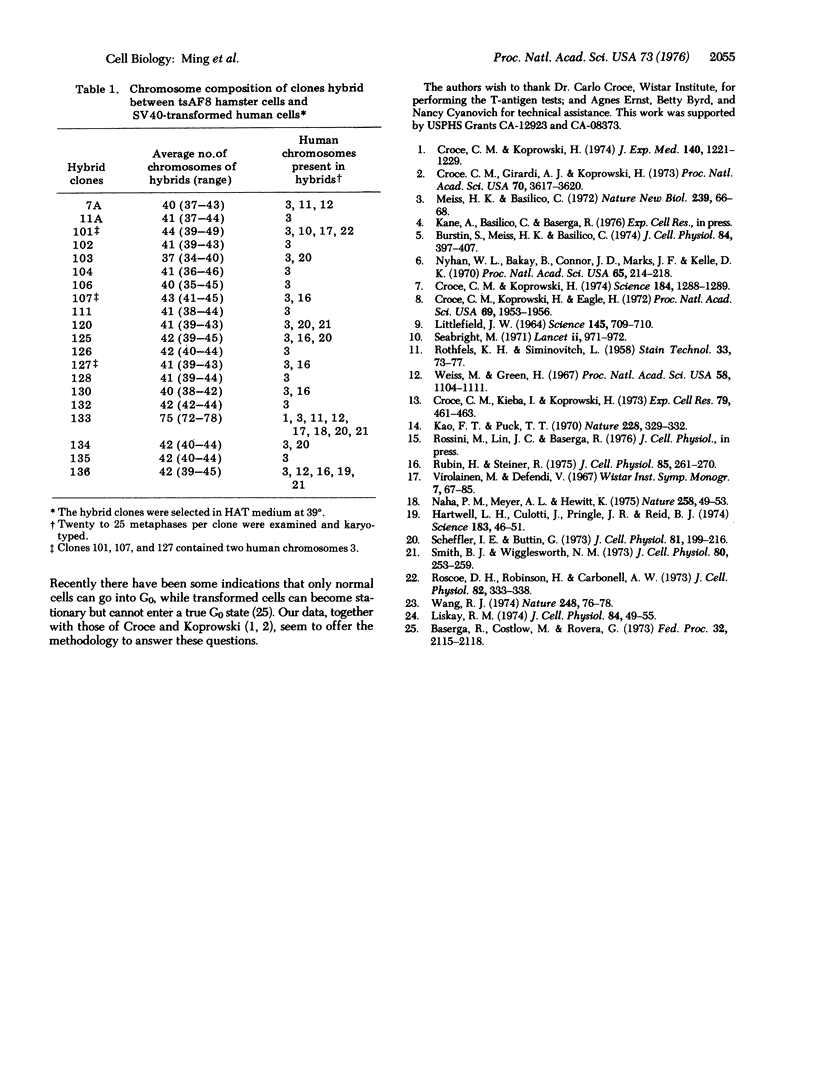Abstract
A temperature-sensitive mutant of Syrian hamster cells, AF8 was fused with simian-virus-40-transformed Lesch-Nyhan fibroblasts; LNSV, in the presence of beta-propiolactone-inactivated Sendai virus. The AF8 cells grow well at 33.5 degrees but are arrested in mid G1 period when shifted to 39 degrees. The LNSV cells are deficient in hypoxanthine guanine phosphoribosyltransferase. The hybrid clones were selected in hypoxanthine-aminopterin-thymidine medium at 39 degrees. A total of 20 clones was isolated and karyotyped. All clones contained most of the hamster chromosomes and one to eight human chromosomes. The preferential retention of human chromosome 3 was observed in 100% of the metaphases of all clones. In nine of the clones, the only human chromosome present was chromosome 3. The results indicate that human chromosome 3 is responsible for conferring to the hybrid cells the ability to grow at nonpermissive temperature for AF8 cells, i.e., the ability to overcome the G1 block. These findings, together with other reports in the cell cycle may be regulated by genes located on different chromosomes.
Full text
PDF



Images in this article
Selected References
These references are in PubMed. This may not be the complete list of references from this article.
- Baserga R., Costlow M., Rovera G. Changes in membrane function and chromatin template activity in diploid and transformed cells in culture. Fed Proc. 1973 Nov;32(11):2115–2118. [PubMed] [Google Scholar]
- Burstin S. J., Meiss H. K., Basilico C. A temperature-sensitive cell cycle mutant of the BHK cell line. J Cell Physiol. 1974 Dec;84(3):397–408. doi: 10.1002/jcp.1040840308. [DOI] [PubMed] [Google Scholar]
- Croce C. M., Girardi A. J., Koprowski H. Assignment of the T-antigen gene of simian virus 40 to human chromosome C-7. Proc Natl Acad Sci U S A. 1973 Dec;70(12):3617–3620. doi: 10.1073/pnas.70.12.3617. [DOI] [PMC free article] [PubMed] [Google Scholar]
- Croce C. M., Kieba I., Koprowski H. Unidirectional loss of human chromosomes in rat-human hybrids. Exp Cell Res. 1973 Jun;79(2):461–463. doi: 10.1016/0014-4827(73)90470-9. [DOI] [PubMed] [Google Scholar]
- Croce C. M., Koprowski H., Eagle H. Effect of environmental pH on the efficiency of cellular hybridization. Proc Natl Acad Sci U S A. 1972 Jul;69(7):1953–1956. doi: 10.1073/pnas.69.7.1953. [DOI] [PMC free article] [PubMed] [Google Scholar]
- Croce C. M., Koprowski H. Positive control of transformed phenotype in hybrids between SV40-transformed and normal human cells. Science. 1974 Jun 21;184(4143):1288–1289. doi: 10.1126/science.184.4143.1288. [DOI] [PubMed] [Google Scholar]
- Croce C. M., Koprowski H. Somatic cell hybrids between mouse peritoneal macrophages and SV40-transformed human cells. I. Positive control of the transformed phenotype by the human chromosome 7 carrying the SV40 genome. J Exp Med. 1974 Nov 1;140(5):1221–1229. doi: 10.1084/jem.140.5.1221. [DOI] [PMC free article] [PubMed] [Google Scholar]
- Hartwell L. H., Culotti J., Pringle J. R., Reid B. J. Genetic control of the cell division cycle in yeast. Science. 1974 Jan 11;183(4120):46–51. doi: 10.1126/science.183.4120.46. [DOI] [PubMed] [Google Scholar]
- Káo F. T., Puck T. T. Genetics of somatic mammalian cells: linkage studies with human-Chinese hamster cell hybrids. Nature. 1970 Oct 24;228(5269):329–332. doi: 10.1038/228329a0. [DOI] [PubMed] [Google Scholar]
- LITTLEFIELD J. W. SELECTION OF HYBRIDS FROM MATINGS OF FIBROBLASTS IN VITRO AND THEIR PRESUMED RECOMBINANTS. Science. 1964 Aug 14;145(3633):709–710. doi: 10.1126/science.145.3633.709. [DOI] [PubMed] [Google Scholar]
- Liskay R. M. A mammalian somatic "cell cycle" mutant defective in G1. J Cell Physiol. 1974 Aug;84(1):49–55. doi: 10.1002/jcp.1040840106. [DOI] [PubMed] [Google Scholar]
- Meiss H. K., Basilico C. Temperature sensitive mutants of BHK 21 cells. Nat New Biol. 1972 Sep 20;239(90):66–68. doi: 10.1038/newbio239066a0. [DOI] [PubMed] [Google Scholar]
- Naha P. M., Meyer A. L., Hewitt K. Mapping of the G1 phase of a mammalian cell cycle. Nature. 1975 Nov 6;258(5530):49–53. doi: 10.1038/258049a0. [DOI] [PubMed] [Google Scholar]
- Nyhan W. L., Bakay B., Connor J. D., Marks J. F., Keele D. K. Hemizygous expression of glucose-6-phosphate dehydrogenase in erythrocytes of heterozygotes for the Lesch-Nyhan syndrome. Proc Natl Acad Sci U S A. 1970 Jan;65(1):214–218. doi: 10.1073/pnas.65.1.214. [DOI] [PMC free article] [PubMed] [Google Scholar]
- ROTHFELS K. H., SIMINOVITCH L. An air-drying technique for flattening chromosomes in mammalian oells grown in vitro. Stain Technol. 1958 Mar;33(2):73–77. doi: 10.3109/10520295809111827. [DOI] [PubMed] [Google Scholar]
- Roscoe D. H., Robinson H., Carbonell A. W. DNA synthesis and mitosis in a temperature sensitive Chinese hamster cell line. J Cell Physiol. 1973 Dec;82(3):333–338. doi: 10.1002/jcp.1040820303. [DOI] [PubMed] [Google Scholar]
- Rubin H., Steiner R. Reversible alterations in the mitotic cycle of chick embryo cells in various states of growth regulation. J Cell Physiol. 1975 Apr;85(2 Pt 1):261–270. doi: 10.1002/jcp.1040850213. [DOI] [PubMed] [Google Scholar]
- Scheffler I. E., Buttin G. Conditionally lethal mutations in Chinese hamster cells. I. Isolation of a temperature-sensitive line and its investigation by cell cycle studies. J Cell Physiol. 1973 Apr;81(2):199–216. doi: 10.1002/jcp.1040810208. [DOI] [PubMed] [Google Scholar]
- Seabright M. A rapid banding technique for human chromosomes. Lancet. 1971 Oct 30;2(7731):971–972. doi: 10.1016/s0140-6736(71)90287-x. [DOI] [PubMed] [Google Scholar]
- Smith B. J., Wigglesworth N. M. Cell line which is temperature-sensitive for cytokinesis. J Cell Physiol. 1972 Oct;80(2):253–259. doi: 10.1002/jcp.1040800212. [DOI] [PubMed] [Google Scholar]
- Virolainen M., Defendi V. Dependence of macrophage growth in vitro upon interaction with other cell types. Wistar Inst Symp Monogr. 1967;7:67–85. [PubMed] [Google Scholar]
- Wang R. J. Temperature-sensitive mammalian cell line blocked in mitosis. Nature. 1974 Mar 1;248(5443):76–78. doi: 10.1038/248076a0. [DOI] [PubMed] [Google Scholar]
- Weiss M. C., Green H. Human-mouse hybrid cell lines containing partial complements of human chromosomes and functioning human genes. Proc Natl Acad Sci U S A. 1967 Sep;58(3):1104–1111. doi: 10.1073/pnas.58.3.1104. [DOI] [PMC free article] [PubMed] [Google Scholar]





